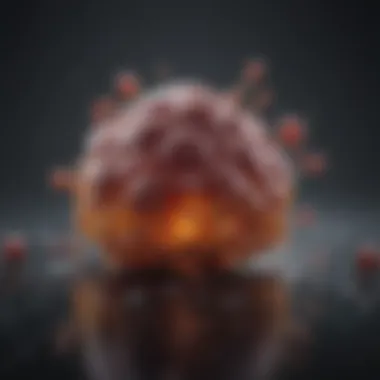Innovative Treatments for Guillain-Barré Syndrome


Intro
Guillain-Barré Syndrome (GBS) distinguishes itself as a complex autoimmune disorder, often triggered by previous infections. This condition manifests primarily through rapid onset muscle weakness, which can escalate to paralysis. The urgency of prompt treatment cannot be overstated, as timely intervention can significantly impact patient recovery. In the following sections, we will delve into the various medicinal approaches currently employed to manage GBS.
Research Highlights
Overview of Key Findings
Recent studies underscore the effectiveness of certain therapies in managing GBS. Treatments such as intravenous immunoglobulins (IVIG) and plasma exchange have emerged as standard care methods. These interventions aim to alter the immune response that contributes to the disease's progression. Research indicates that early administration of these therapies correlates with improved clinical outcomes and a reduction in the duration and severity of symptoms.
Additionally, ongoing clinical trials are exploring novel agents that may offer further benefits in treatment protocols. Potential new drugs are under investigation, with hopes of enhancing immune modulation or targeting specific pathways involved in nerve damage.
Significance of the Research
Understanding GBS holds substantial significance not just for patients but also for medical professionals. The disorder affects a diverse population, and as such, advances in research offer new avenues for treatment strategies. By keeping abreast of the latest findings, healthcare providers can refine their approaches, ultimately contributing to better outcomes and improved quality of life for those afflicted.
Current Treatments
- Intravenous Immunoglobulin (IVIG): This treatment involves high doses of immunoglobulins which come from donors. It acts to modify the immune response, reducing the harmful effects on the nervous system.
- Plasma Exchange (Plasmapheresis): This therapy entails removing blood plasma from the patient, which contains antibodies that may be mistakenly attacking nerves. Replacing the plasma helps in alleviating symptoms more swiftly.
Both treatments have been subjected to numerous clinical trials and are deemed effective based on accumulated data. According to a study available on Wikipedia, early intervention plays a crucial role in recovery potential.
Future Directions in Research
Ongoing research aims to better define the pathophysiology of GBS, which remains an area of interest among scientists. By understanding the mechanisms at play, targeted therapies can be developed, potentially enhancing recovery rates.
Moreover, the exploration of biologics and small-molecule drugs is on the rise. These agents would focus on specific immune pathways, offering a tailored approach to treatment rather than a one-size-fits-all solution.
Culmination
The complexity of Guillain-Barré Syndrome requires ongoing research and adaptation of treatment strategies. With current therapies showing promise and future investigations looking to expand on these findings, it is an exciting time for those involved in this field. Understanding both the disease and the medicinal approaches is vital for effectively addressing this debilitating condition.
Understanding Guillain-Barré Syndrome
Understanding Guillain-Barré Syndrome (GBS) is crucial for both medical professionals and patients alike. This condition, characterized by rapid muscle weakness and paralysis, poses significant challenges in clinical management. By exploring its underlying mechanisms, epidemiology, and clinical presentation, we can appreciate the complexities of GBS. This section serves as a foundational aspect of the article, guiding readers through the fundamental elements that shape our approach to medical interventions for GBS.
Pathophysiology of GBS
Guillain-Barré Syndrome is primarily an autoimmune disorder. It occurs when the body's immune system mistakenly attacks its own peripheral nerves, leading to inflammation and demyelination. The exact cause remains unclear, but it is often preceded by infections, such as Campylobacter jejuni, cytomegalovirus, or Zika virus. The immune response targets myelin— the protective sheath surrounding nerves—resulting in symptoms such as weakness, numbness, and in severe cases, respiratory failure.
In addition, studies indicate the possible role of molecular mimicry in this syndrome. In this context, the immune system confuses components of the nerve cells with those of infectious agents. This misguided response triggers the cascade of symptoms observed in GBS. Understanding these mechanisms is vital as it can guide future therapeutic strategies aimed at mitigating the autoimmune response while preserving nerve function.
Epidemiology and Risk Factors
The epidemiology of GBS offers valuable insight into the populations most affected by this syndrome. GBS is relatively rare, with an incidence of about one to two cases per 100,000 people annually. It can affect individuals of any age but is more prevalent in adults and older adults.
Several risk factors contribute to the development of GBS. These may include:
- Infectious diseases: As mentioned earlier, preceding infections greatly increase the risk of GBS.
- Age: Older individuals are more susceptible.
- Gender: Some studies note a slight male predominance in GBS cases.
- Vaccinations: While rare, there is an association between certain vaccines and GBS onset. However, the benefits of vaccination generally outweigh these risks.
Understanding these epidemiological aspects allows for better risk assessment and management strategies, particularly in vulnerable populations.


Clinical Presentation and Diagnosis
The clinical presentation of GBS can vary widely among patients, but it typically starts with a moderate, progressive weakness that may lead to severe paralysis. Symptoms often begin in the legs and may ascend, affecting the upper body. Associated signs can include:
- Tingling or numbness in the extremities
- Muscle pain
- Difficulty with coordination and balance
- In severe cases, respiratory muscle weakness requiring intervention
Diagnosis relies heavily on clinical evaluation, including the patient's history and a physical examination. Laboratory tests such as cerebrospinal fluid analysis and nerve conduction studies are invaluable. An elevated protein level in the cerebrospinal fluid with a normal white cell count is a classic finding in GBS, known as albuminocytologic dissociation. EMG studies can demonstrate characteristic findings of demyelination.
Understanding these clinical presentations and diagnostic criteria is essential for healthcare providers to initiate timely and appropriate treatments, ultimately improving patient outcomes.
Current Pharmacological Treatments
Current pharmacological treatments for Guillain-Barré Syndrome (GBS) are essential in managing the disease effectively. They aim to modify the immune response that underlies the condition. The treatments focus on alleviating symptoms, hastening recovery, and possibly minimizing the long-term consequences of GBS. Understanding the specifics of each treatment modality is crucial for both clinicians and researchers.
Intravenous Immunoglobulin Therapy
Mechanism of Action
Intravenous Immunoglobulin (IVIG) therapy involves administering a concentrated solution of immunoglobulins extracted from the plasma of many donors. This therapy works by modulating the immune system. More specifically, it neutralizes abnormal antibodies and blocks the damaging interactions between immune cells and peripheral nerves. The benefit of IVIG is its relatively rapid action, making it a valuable choice for acute GBS treatment. Its unique feature lies in its ability to provide passive immunity, which can help in controlling the autoimmune process.
Indications and Efficacy
The primary indication for IVIG therapy is in acute cases of GBS, especially during the initial treatment phase. Studies suggest that IVIG can significantly improve recovery speed and reduce the risk of long-term complications. Its efficacy is supported by evidence from various clinical trials showing improved motor recovery in treated patients compared to those who receive placebo or no treatment. However, it is important to consider that while IVIG has proven effective, not all patients respond equally well.
Potential Side Effects
IVIG therapy can cause several side effects, although they are usually mild to moderate. Common side effects include headache, fever, chills, and fatigue. Rare but serious effects like thromboembolic events and acute renal failure may occur. The unique feature here is the risk of complications, especially in patients with pre-existing conditions. While IVIG is generally safe, clinicians must weigh the benefits against these potential risks before administration.
Plasmapheresis
Process Overview
Plasmapheresis is a procedure involving the removal of plasma from the blood. It helps in eliminating the harmful antibodies that are believed to contribute to nerve damage in GBS. The process usually takes several hours and requires specialized equipment. The key characteristic of this treatment is its direct targeting of the immune factors responsible for GBS. This specificity makes plasmapheresis a beneficial choice, especially in severe cases of the disease.
Benefits and Risks
The benefits of plasmapheresis include rapid clinical improvements and a potential decrease in the duration of symptoms. Research indicates that this therapy may also shorten hospital stays for GBS patients. However, risks include infection, bleeding, and vascular complications. The unique challenge with this treatment lies in balancing the therapeutic benefits while managing the risks associated with the procedure.
Comparison with Other Treatments
When comparing plasmapheresis with other treatments like IVIG, it becomes evident that both have unique advantages. Plasmapheresis is often preferred in severe cases, while IVIG may be easier to administer and has a better overall safety profile. The choice between treatments depends on various factors including severity of the condition, patient comorbidities, and clinical judgment. Thus, a tailored approach is crucial in GBS management.
Corticosteroids Usage
Role in GBS Management
Corticosteroids are anti-inflammatory medications traditionally used for various autoimmune conditions. In GBS, their role is more controversial. Some studies suggest that corticosteroids might be beneficial when used as an adjunct therapy. However, their use in acute GBS has not shown consistent benefits on recovery. This inconsistency makes the understanding of corticosteroid effectiveness in GBS management more complicated.
Controversies in Efficacy
Debate surrounds the effectiveness of corticosteroids in GBS. While some clinicians advocate for their use based on theoretical benefits, clinical evidence generally does not support improved outcomes related to motor recovery. The unique aspect here is that while corticosteroids may help reduce inflammation, the lack of clear evidence for their efficacy in GBS raises questions about their role. Researchers continue exploring corticosteroids’ full potential in GBS therapy.
Clinical Considerations


From a clinical standpoint, the use of corticosteroids in managing GBS requires careful consideration. Their potential interactions with other treatments and the patient’s overall health must be assessed. The unique feature to keep in mind is the importance of personalized treatment plans, as not all patients will benefit the same way from corticosteroid therapy. This emphasizes the need for ongoing research and refinement of treatment protocols for GBS.
Emerging Therapies and Research
Emerging therapies and research are essential in the context of Guillain-Barré Syndrome (GBS). This area not only reflects advancements in medical science but also aims to improve the management of this complex autoimmune disorder. New treatments can lead to better patient outcomes and address the limitations of current therapies, giving patients hope for a more effective recovery process. The exploration of innovative approaches continues to unveil potential benefits that could significantly alter the landscape of GBS treatment.
Monoclonal Antibodies in GBS
Preclinical Studies
Preclinical studies focusing on monoclonal antibodies in GBS represent a crucial step in understanding their potential efficacy. These studies often use animal models to assess the effectiveness and safety of new therapies before human trials. The key characteristic of preclinical studies is their ability to simulate the human response to new treatments under controlled circumstances. This aspect is beneficial as it allows for early identification of potential side effects and therapeutic benefits. A unique feature of these studies is that they can advance rapidly, providing essential insights that pave the way for clinical trials. However, they also have limitations due to differences in how human bodies react compared to animal models.
Clinical Trials Updates
Clinical trials updates are vital to maintaining awareness of the latest findings in monoclonal antibody therapy for GBS. These updates serve to inform both practitioners and researchers of progress being made in the efficacy of specific treatments. The primary characteristic of these updates is their focus on ongoing and completed trials that assess the safety and effectiveness of new medications. They are a popular choice for researchers since they guide clinical practice and adjust treatment strategies. A notable aspect is the potential for promising results that enhance treatment options for patients. Yet, the disadvantage is that results can vary based on participant diversity and trial methodologies, leading to uncertainty in broader applicability.
Expected Outcomes
Expected outcomes of monoclonal antibody treatments are a focal point for researchers and clinicians addressing GBS. These outcomes are defined in terms of efficacy, safety, and the overall quality of life improvements for patients. A significant attribute of expected outcomes is the clear indicators they provide regarding the success of a treatment. They are beneficial for both patient care and research as they offer measurable goals for therapy. One unique feature lies in the possibility of setting realistic expectations for patients, fostering better communication about what they can anticipate from treatment. However, one must consider that anticipated results may not always include comprehensive individual responses, complicating treatment planning.
Immune Modulation Strategies
Mechanisms of Action
Understanding the mechanisms of action of immune modulation strategies is crucial for developing effective treatments for GBS. These mechanisms describe how therapies influence the immune system to reduce inappropriate responses. The key characteristic of this understanding is its foundation in immunology, which informs how specific agents can effectively modify immune responses to combat GBS. Its benefit stems from tailoring treatments based on individual patient needs, enhancing overall therapy effectiveness. A unique aspect is the diverse ways immune modulation can occur, from downregulating inflammatory processes to promoting healing without compromising the immune defense, although the complexity of individual immune responses can make predictions challenging.
Clinical Evidence
Clinical evidence in the realm of immune modulation strategies provides a basis for determining the feasibility and effectiveness of various therapies in GBS patients. This evidence is key in guiding medical professionals in choosing treatment pathways. Its strength lies in current research supporting these strategies, with real-world applicability expanding as more data becomes available. However, the unique feature is often a reliance upon varied clinical trials which may have differing methodologies. Such diversity can introduce disadvantages in drawing consolidated conclusions, requiring careful consideration in interpreting results.
Ongoing Projects
Ongoing projects focusing on immune modulation strategies for GBS reveal the continued commitment to advancing treatment. These projects may include collaborative efforts among major research institutions to validate hypotheses about treatment efficacy. Their main characteristic is being dynamic, constantly updated as new findings emerge and data is collected. Such projects are beneficial as they keep the medical community informed about cutting-edge developments. Unique features often include multidisciplinary approaches combining various expertise, although funding and resource limitations can hinder progress and slow the introduction of new therapies.
Gene Therapy Possibilities
Current Insights
Current insights into gene therapy applications for GBS illustrate the potential for transformative therapies in this field. This aspect focuses on the ability to correct or modify faulty genes linked to autoimmune responses. The key characteristic of these insights is their foundation in genetic research, promising innovative approaches to treatment. These insights are beneficial because they target the root causes of diseases rather than just the symptoms. However, a unique feature of this is the intricate nature of genetic manipulation, leading to ethical concerns and regulatory hurdles that can complicate implementation.
Potential Benefits
The potential benefits of gene therapy lie in its ability to offer long-term solutions for GBS patients, perhaps even before symptom onset. These benefits include tailored therapies that directly impact the genetic mechanisms behind the disease. The primary characteristic of potential benefits is their transformative impact, shifting the focus from palliative treatment to potentially curative methodologies. However, this also introduces a unique challenge, where the success of such interventions greatly relies on patient-specific genetic factors, potentially limiting its widespread applicability.
Challenges and Limitations
The challenges and limitations of gene therapy are significant considerations that researchers must address. Understanding these challenges is crucial for developing realistic expectations for the implementation of such therapies. A primary characteristic is the complexity of human genetics, which can lead to unpredictable outcomes when therapies are applied. This focus is beneficial as it informs researchers and clinicians about the hurdles they may face. A unique feature includes the need for extensive testing and validation before treatments can be deemed safe for general use, complicating timelines for introducing novel therapies.
Supportive Care and Rehabilitation
Supportive care is crucial for the management of Guillain-Barré Syndrome (GBS). This condition can result in severe muscle weakness and potential paralysis, which makes rehabilitation a vital component of the treatment plan. Supportive care aims to maintain physical function and enhance quality of life for patients. It encompasses a variety of strategies, including physical therapy, occupational therapy, and psychological support. These elements work together to promote recovery and help patients regain independence.
Physical Therapy Approaches


Physical therapy is a cornerstone of rehabilitative care for GBS patients. The primary focus is on restoring movement and strength. Patients often undergo tailored exercise programs designed to rebuild muscle strength gradually. Early intervention is key; as soon as the patient's condition allows, movement should be encouraged.
The following benefits of physical therapy stand out:
- Improved Mobility: Regular physical activity helps patients regain their ability to move and perform daily tasks.
- Reduced Muscle Atrophy: Engaging in therapy combats muscle wasting and helps maintain muscle tone.
- Pain Management: Specific exercises can alleviate discomfort associated with muscle weakness and stiffness.
Therapists assess each patient’s needs and capabilities to create a personalized plan. This individual focus enables them to adapt exercises based on the progression of the patient’s recovery, ensuring that the therapy is neither too strenuous nor too easy.
Occupational Therapy and Daily Living Skills
Occupational therapy is equally important for GBS patients. This therapy focuses on enabling individuals to participate in daily activities despite their limitations. Occupational therapists evaluate the specific challenges faced by patients, developing strategies and adaptive equipment to assist in daily tasks.
Key elements include:
- ADLs (Activities of Daily Living): Therapists work with patients on essential activities such as dressing, grooming, and eating. They may suggest assistive devices or techniques to simplify these tasks.
- Home Modifications: Suggestions for adapting the home environment ensure safety and ease. Simple adjustments like grab bars or modified furniture can make a significant difference.
- Workplace Return: For those who are employed, occupational therapy aids in developing strategies for a gradual return to work, addressing physical demands and job-specific tasks.
This comprehensive support enhances patients' functional capabilities and helps restore a sense of normalcy in their lives.
Psychological Support and Counseling
Psychological support plays a fundamental role in the rehabilitation process for GBS patients. The experience of a sudden and severe illness can lead to significant emotional distress, including anxiety, depression, and frustration with the loss of physical abilities.
Key considerations in this aspect of care include:
- Counseling Services: Mental health professionals can provide a space for patients to express their feelings, helping them cope with the emotional challenges of recovery.
- Support Groups: Participation in peer support groups offers a chance for patients to connect with others who face similar challenges, fostering a sense of solidarity.
- Stress Management Techniques: Therapists might teach methods such as mindfulness or relaxation techniques to manage stress and promote resilience.
Effective psychological support can significantly improve the overall recovery outcomes for patients, reinforcing the importance of mental well-being in physical rehabilitation.
Supportive care and rehabilitation are instrumental in overcoming the challenges posed by Guillain-Barré Syndrome. By integrating physical, occupational, and psychological therapies, healthcare providers can facilitate a more comprehensive recovery pathway, ultimately promoting better patient outcomes.
Future Directions in GBS Management
Future directions in the management of Guillain-Barré Syndrome (GBS) represent a crucial aspect of ongoing medical research and clinical practice. As our understanding of GBS continues to evolve, it becomes increasingly clear that traditional treatment approaches, while effective, may not sufficiently address the diverse manifestations of the syndrome. This opens the door for innovative methods that can be tailored to the individual needs of patients. With advancements in the fields of genetics, immunology, and technology, future strategies hold promise not only for improving recovery rates but also for enhancing the overall quality of life among GBS patients.
Personalized Medicine Approaches
Personalized medicine is a transformative concept in healthcare that tailors treatment plans to the specific characteristics of each patient. In GBS management, this approach can significantly improve outcomes. By considering genetic factors, autoimmune profiles, and individual responses to certain treatments, clinicians may provide more effective interventions.
Current research indicates that genetic predispositions can influence disease severity and recovery routes. For example, specific gene variants may alter immune responses. Consequently, identifying these variants might allow healthcare providers to predict the course of GBS in patients and customize therapies accordingly. Furthermore, biomarkers could aid in determining which therapies are likely to be most beneficial for particular patient subgroups.
In addition, pharmacogenomics—the study of how genes affect a person’s response to drugs—can aid in selecting the most appropriate medications for managing GBS. This shift toward personalized treatments emphasizes the need for further research to develop clearer protocols that incorporate genetic insights into everyday clinical practice.
Collaboration Between Research and Clinical Practice
The collaboration between research institutions and clinical practices is essential for advancing GBS management. This partnership can facilitate the translation of laboratory findings into practical therapeutic applications. By fostering these relationships, researchers can obtain insights into real-world treatment efficacy, while clinicians can contribute feedback on the applicability of experimental therapies in diverse patient populations.
Regular interdisciplinary meetings can provide a platform for exchanging information on ongoing studies, clinical trials, and emerging therapeutic options. This shared knowledge enhances the overall understanding of GBS pathology and treatment effectiveness.
Additionally, incorporating healthcare professionals from various specialties—neurologists, immunologists, physical therapists, and rehabilitation specialists—into research initiatives can promote holistic approaches for managing patients with GBS.
Global Perspectives on GBS Research
Global collaboration is vital to propel GBS research forward. Different regions may present unique data regarding epidemiology and treatment responses, which can enhance understanding of the syndrome's complexities. Areas with varying genetic backgrounds and healthcare infrastructures offer insights that can refine management strategies.
International research networks can play a key role in aggregating data and facilitating clinical trials across borders. This effort can accelerate the development of effective treatment modalities and improve access to innovative therapies.
Moreover, sharing resources and findings with global health organizations can ensure a broader implementation of successful treatment protocols. Continued emphasis on education regarding GBS in diverse populations is also critical, allowing for better awareness and quicker responses to this condition.
"The strength of future GBS management lies in our ability to adapt to new findings and cultivate partnerships across disciplines and borders."







